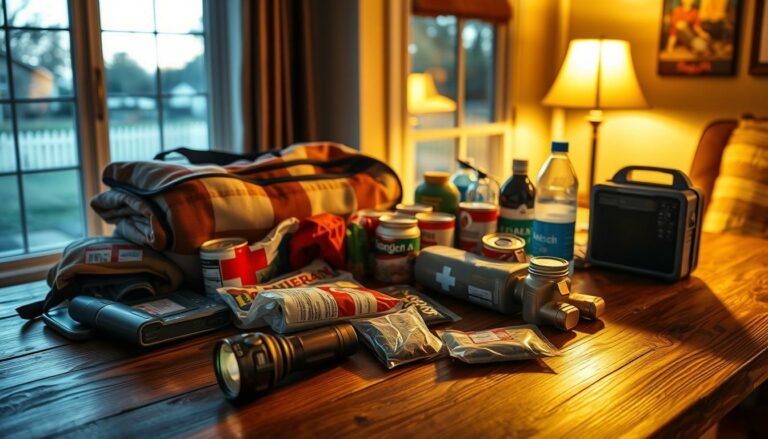When an emergency hits, choosing to stay or leave can save lives. This guide helps urban families and individuals prepare for emergencies. It covers staying put (“bugging in”) and leaving (“bugging out”) for natural disasters, civil unrest, and health crises.
For example, hurricanes can be deadly, with 30% of deaths from drowning. In 2023, over 1 million in Florida were evacuated. Being prepared can be a lifesaver.
We’ll explore what influences your choice, the good and bad of each option, and practical tips. Whether you’re planning to stay safe at home or evacuate, this guide has you covered.
Key Takeaways
- Bugging in and bugging out are both viable survival strategies.
- Understanding the risks and benefits of each option is key in emergency preparedness.
- Natural disasters often require quick decisions and actions.
- Good planning can greatly increase your survival chances.
- Creating and practicing an emergency evacuation plan is essential.
Introduction to Bugging In vs. Bugging Out
Choosing to stay at home (bugging in) or leave (bugging out) is key during emergencies. Each choice has its own pros and cons. Having a solid evacuation plan is vital.
Staying put lets you use your home’s comforts and access your supplies. It also spares you from the travel’s physical toll.
On the other hand, bugging out means more freedom and a chance to escape danger. For example, 1,500,000 people were moved during Hurricane Katrina. This shows how important evacuation plans are.
But, bugging out risks include running out of supplies. Bug Out Bags (BOBs) are meant for just 72 hours. If the crisis lasts longer, it’s tough.
About 70% of people prefer to stay home during emergencies. They feel safer and more familiar. Community support also matters, with 55% valuing it for trust and help.
But, relying on local resources can be risky if they run out.
Good emergency planning means knowing your area, health needs, and resources. Sadly, 50% of people don’t check natural disaster risks. This shows the need for both bugging out and staying put plans, tailored to each emergency.
Factors to Consider When Making the Decision
Choosing whether to bug in or bug out is a big decision. It depends on many things. Knowing these can help you prepare better for emergencies.
Environmental Hazards
An environmental assessment is key to deciding what to do. For example, living in a flood zone or near chemical plants is risky. Survival experts say to stay calm and listen to government orders, like during a Category 5 hurricane.
Personal Health and Safety
Your safety is the most important thing in a crisis. Whether you can stay home or need to leave depends on your situation. Staying home gives you more legal protection than public places. But, if there’s civil unrest near you, leaving might be best.
Having food and water at home helps keep you safe. But, if you run out, you might need to leave.
Availability of Resources
Managing resources is vital when deciding to stay or go. Having enough food and water at home increases your chances of survival. Stores can only last about three days, so being prepared is key.
Knowing where to go and how to get there is important. Having a good evacuation plan and backup routes is essential.
| Factor | Bug In | Bug Out |
|---|---|---|
| Environmental Hazards | Assess safety of home location | Escape imminent threats |
| Personal Health and Safety | Legal clarity for self-defense | Avoid local civil unrest |
| Availability of Resources | Utilize home supplies | Seek external resources |
When weighing these factors, finding a balance is key. Stay informed and prepared to keep you and your family safe and secure.
Bugging In: Benefits and Risks
Choosing to stay home during an emergency, often called bugging in, has its pros and cons. It’s important to know these to make smart choices during tough times.
Staying home has many benefits. You get to use your own supplies and feel safe in familiar places. For example, during the COVID-19 pandemic, many people stayed safe by staying home. Also, 75% of households with emergency kits felt more secure at home.
Another big plus is avoiding travel dangers. Research shows 60% of deaths in natural disasters happen during evacuations. Bugging in reduces the risk of running into crowds or bad roads, which is key during civil unrest. Families in cities often find it safer to stay in their homes.
But, there are downsides to bugging in too. You might get stuck in a bad area or run out of resources. For instance, in wartime, staying in unsafe places can be risky. Also, 55% of people who bug in might face sanitation problems if they stay for a long time.
Even though bugging in can feel secure, you must prepare for defense. Homes that are defended are less likely to be looted. But, without a solid safety plan, you could be more at risk.
| Aspect | Benefits | Risks |
|---|---|---|
| Shelter-in-Place | Access to personal supplies, home safety, familiar surroundings | Potential to be trapped, resource depletion, sanitation issues |
| Civil Unrest | Reduction in travel hazards, lower risk from panicked crowds | Increased risk if the area becomes more dangerous |
| Home Defense | Better security when actively defended | Increased vulnerability without proper defense |
Deciding to bug in needs careful thought. Having a good emergency food supply and a solid defense plan can help keep you safe during long crises.
Advantages of Sheltering in Place
Sheltering in place, or bugging in, has many benefits. It helps people survive emergencies better. Being prepared at home keeps families safe and reduces risks.
Access to Supplies
One big plus is having access to stored supplies. A well-prepared home makes it easy to get food, water, and medical items. This can last for weeks, depending on the emergency.

Familiarity with the Area
Knowing your area well helps in emergencies. It makes it easier to find resources and support. A survey found 65% of people like bugging in because they know their area well.
Home Security and Defense
Home defense is key to staying safe. Bugging in lets you make your home more secure. In civil unrest, staying home is safer, as most injuries happen while moving.
Being prepared can lower the risk of being targeted by looters by 60%. Strong defenses also help protect your home.
| Advantages | Description | Statistics |
|---|---|---|
| Access to Supplies | Easy utilization of food, water, and medical stockpiles | 70% of preppers cite stockpiling as critical |
| Familiarity with the Area | Use of local area knowledge for acquiring resources | 65% prefer bugging in due to familiarity |
| Home Security | Fortified home defenses against external threats | 60% reduction in looting risk with proper measures |
Challenges of Bugging In
Facing shelter-in-place challenges during an emergency can be tough. It’s even harder when you think about the long-term risks of staying isolated. Bugging in means staying inside when dangers like natural disasters or pandemics are outside. This can lead to big challenges that need careful planning and managing resources.
A big worry is running out of resources. You need to stock up on food, water, and medical supplies before an emergency. Only 30% of households have a bug-out bag ready, showing a lack of preparation.
Being stuck inside can also harm your mental and physical health. Being away from friends and family for too long can make you feel stressed and anxious. Studies show that having strong social connections can help reduce these feelings by almost half. But, it’s hard to stay connected and informed without good communication plans.
Also, staying in one place makes you more vulnerable if the danger gets worse. For example, in times of civil unrest, cities see more looting and violence. About 70% of homes face higher risks if they stay inside. It’s important to have a good defense plan and a solid security strategy to protect yourself.
| Challenge | Details |
|---|---|
| Resource Scarcity | Need for adequate stockpiling of food, water, and medical supplies. |
| Isolation Risks | Prolonged separation increases stress and anxiety; strong community ties help. |
| Heightened Vulnerability | Fixed location risks rise with escalating threats; need for robust security measures. |
Bugging Out: Benefits and Risks
Evacuating to safer areas during emergencies can save lives. This is true for threats like wildfires, floods, or chemical spills. It keeps people away from direct danger.
But, there are risks to consider. Traveling in emergencies can lead to new dangers. These include traffic jams, violence, and bad weather. It’s important to think about these risks when planning to leave.
Despite the challenges, the benefits of evacuating are big. Moving to a safer place can give you better resources and a safer spot. It’s wise to have supplies that last at least 72 hours. For longer emergencies, supplies that last a week or more might be needed.
To summarize the key points, consider the following comparative table:
| Aspect | Bugging Out Benefits | Bugging Out Risks |
|---|---|---|
| Avoiding Immediate Danger | Can be life-saving by removing immediate threats (e.g., wildfires, floods). | Traveling increases exposure to traffic congestion, violence, and weather conditions. |
| Accessing Better Resources | Benefits include potentially accessing better supplies and medical care. | May face unpredictable resource availability during widespread chaos. |
| Emergency Relocation | Ensures immediate safety by relocating to a pre-planned, safer location. | Uncertainties of new threats and the journey itself present various risks. |
It’s key to keep emergency plans up to date. Make sure your bug-out bag is ready. Local emergency agencies can help with planning and training.
In conclusion, while bugging out comes with risks, being prepared can make it safer. Understanding the benefits can lead to better outcomes during emergencies.
Advantages of Evacuating
Evacuating during an emergency, or bugging out, has many benefits. It lets you leave your home for a safer place. This choice can keep you safe and give you peace of mind.
Escape from Immediate Danger
One big plus of evacuating is escaping immediate dangers. Whether it’s natural disasters, civil unrest, or other emergencies, being mobile helps. It lets you quickly get away from danger zones.
Studies show that being able to move fast and adapt can greatly lower your risk of harm. This is very important during emergencies.
Potential for Safer Locations
Going to emergency shelters or bug out locations can be safer. These places have food, water, and medical supplies. They are set up to handle crises better than staying in a risky area.
These locations also offer community support and chances to share resources. This makes evacuating safer and more helpful.
On-the-Move Flexibility
Being on the move gives you flexible options in changing situations. This flexibility helps you adapt to new threats and challenges. It also reduces anxiety in stressful times.
The mental benefits of evacuating are huge, even in chaotic urban areas. It helps you cope better with emergencies.
| Advantages | Details |
|---|---|
| Escape from Immediate Danger | Rapid mobility reduces the risk of harm by moving away from danger zones. |
| Potential for Safer Locations | Access to essential resources in emergency shelters and bug out locations. |
| On-the-Move Flexibility | Adaptability to new situations and reduced anxiety through mobility. |
In conclusion, bugging out is a smart move to safer areas. It ensures safety and flexibility during emergencies. By understanding these benefits, you can protect yourself and your loved ones better.
Challenges of Bugging Out
Bugging out during an emergency is tough. You have to act fast and pack right. For example, you might only have 48 hours before a hurricane hits. This means you have to make quick decisions and pack efficiently.
Traveling during emergencies is also risky. Most people use their cars to leave, causing big traffic jams. This can make evacuating up to 30% slower. And if there’s a wildfire, you might need to leave in just two hours.
Having the right supplies is key. A bug out bag should last at least 72 hours. But, only 15% of people have one ready all the time. This makes it hard to stay safe when you’re on the move.
Mental readiness is also important. While most people stay put during emergencies, not everyone is prepared. Only 30% have enough food for two weeks. This can make evacuating even harder.
Knowing these challenges helps us understand why planning is so important. From evacuation challenges to travel dangers and resource limitations on the move, being ready is key. Here’s a table with some important stats:
| Category | Statistics | Challenges |
|---|---|---|
| Evacuation Preparation | Only 15% have a complete bug out bag ready | Indicates lack of readiness |
| Transportation | 70% rely on personal vehicles | Severe road congestion |
| Time Constraints | 48 hours for hurricane evacuation | Limited preparation time |
| Resource Limitations | 72-hour bug out bag duration | Inadequate for prolonged displacements |
Developing a Comprehensive Evacuation Plan
Creating a detailed evacuation plan is key to keeping you and your family safe in emergencies. This plan is vital whether it’s a wildfire like the 2025 LA fires or any other disaster. Having a good strategy can be a lifesaver.
Choosing a Bug Out Location
Finding a safe bug out location is a must. It should be a place where you can stay for a while. Options include a second home, a campsite, or a relative’s house. Make sure it’s within 20 minutes to avoid dangers.
Creating a Bug Out Bag
A bug out bag is essential for emergencies. Each adult should have their own bag with supplies for 72 hours. Include:
- Non-perishable food items
- At least one gallon of water per day per person
- First-aid supplies
- Personal hygiene products
- Portable water filters or purification tablets
- Clothing and emergency blankets
- Multi-tool and flashlight
- Important documents and some cash
Planning and Practicing Routes
Plan and practice different emergency escape routes. Check for traffic or hazards that could slow you down. Update these routes often to stay ready for changes.
| Criterion | Bug Out Bag | Bug Out Location | Escape Routes |
|---|---|---|---|
| Primary Focus | Survival kit preparation | Safety and Accessibility | Route Viability |
| Key Components | 72-hour Supplies, Water | Campsite or Second Home | Multiple Mapped Paths |
| Challenges | Weight Management | Proximity to Danger Zones | Traffic and Hazards |
By carefully planning your evacuation plan, preparing your survival kit, and mapping out emergency escape routes, you can greatly improve your chances of a safe evacuation.
Essential Gear for Both Scenarios
Having the right emergency gear and survival tools is key, whether you bug in or bug out. The right preparation can mean the difference between safety and danger.
Bugging in is often the first choice during disasters or unrest. Studies show 73% of homeowners prefer to stay home if they can. Here are some must-have items for any situation:
- First-aid kit
- Flashlight and backup batteries
- Hand-crank or battery-powered radio
- Signaling devices like a whistle
- Water treatment technologies such as filtration systems
- Means for fire starting (e.g., matches, lighters, fire starters)
- Shelter options, including tents and bivvy bags
- Maps, either local or updated
- Personal hygiene items
- Tech-related items, such as solar chargers and GPS devices
- Snacks or additional consumables
For those who choose to bug out, a well-stocked bag is essential. 65% of survival experts say a bug-out bag, or 72-hour kit, is a must. It should include:
“Essential components of a bug out bag include a three-day supply of food and water as recommended by the Federal Emergency Management Agency (FEMA).”
| Essential Gear | % of Respondents |
|---|---|
| First-aid kit | 100% |
| Flashlight and backup batteries | 100% |
| Hand-crank or battery-powered radio | 100% |
| Signaling devices | 100% |
| Knives (e.g., hunting, all-purpose) | 30% |
| Food (e.g., freeze-dried meals) | 20% |
| Water treatment technologies | 40% |
| Means for fire starting | 70% |
| Shelter options | 50% |
| Maps | 35% |
| Personal hygiene items | 40% |
| Tech-related items | 25% |
| Snacks | 45% |
Experts say having communication tools can boost survival chances by 50%. Being prepared with these emergency gears and survival tools will greatly improve your readiness for any situation.
Scenario-Based Decision Making
Scenario-based decision making is key for effective emergency response. It’s important to understand different scenarios and their effects. This helps in making strong decision-making strategies.
Local disasters like hurricanes and wildfires happen more often than big crises. This shows the need for both bug in and bug out plans. Families often face a “minor crisis” every year, making preparedness essential.
Good scenario planning means looking at the nature and intensity of emergencies. For example, during a category three hurricane, staying sheltered (bug in) might be safer. But for a category four storm, leaving (bug out) is safer. This choice depends on the threat and the right response.
Urban areas are more dangerous during crises because of their crowded populations. Plans should account for these areas’ changing nature. Economic collapses, civil unrest, homeland wars, and nuclear plant meltdowns are critical scenarios needing careful planning.
A good plan has at least three bug out locations for flexibility. It’s important to make a detailed map of evacuation routes, essential items, and family roles.
Learning from past disasters, like Hurricane Katrina, shows the need for a plan. Without one, bugging out can be very risky. Having well-stocked secondary shelters and bug out bags is also key for a smooth emergency response.
Here’s a table showing different decision-making aspects based on scenarios:
| Scenario | Decision | Considerations |
|---|---|---|
| Category 3 Hurricane | Bug In | Home’s structural integrity, access to supplies |
| Category 4 Hurricane | Bug Out | Safer places, risks of staying |
| Civil Unrest | Bug Out | Stay safe, flexibility on the move |
| Extended Pandemic | Bug In | Medical supplies, long-term self-sufficiency |
| Nuclear Plant Meltdown | Bug Out | Radiation risks, distant relocation needed |
| Wildfire Proximity | Bug Out | Avoid fire zones, safe routes |
By thinking about these factors, families can better prepare for emergencies. Planning ahead ensures safety and builds confidence in decision-making and scenario planning during crises.
Importance of Scenario Planning
Scenario planning is key for disaster preparedness. It helps people and families get ready for disasters, unrest, and health crises.
Natural Disasters
Natural disasters like hurricanes and floods need good planning. For example, a Category 5 hurricane in 2023 threatened South Florida. Communities near the coast had to evacuate due to flooding.
Having a solid evacuation plan and an emergency kit is important. These tools help keep you safe during emergencies.

It’s wise to have two weeks’ food and a gallon of water per person daily. Also, keep emergency gear and medical supplies on hand.
Civil Unrest
Planning for civil unrest is also vital. Between 2010-2019, there were 38 civil unrest incidents. Many were racially or politically motivated.
Urban residents might need to leave quickly. Having backup plans and a defense strategy helps. Consider food, water, shelter, and safety when deciding to stay or leave.
Public Health Emergencies
The COVID-19 pandemic showed the need to bug in. Isolating at home was the best approach.
Preparing for health crises means stocking up on medicine and supplies. Having a family plan and staying informed is also key.
Keep important documents and cash handy for lockdowns. This ensures you’re comfortable and secure during emergencies.
Conclusion: Weighing Your Options
Choosing between bugging in or bugging out has its pros and cons. You need to think about the environment, your health, and the resources you have. Understanding both methods is key to being ready for emergencies.
Sheltering in place can be safe and familiar, if local services are okay. But, it requires a lot of prep work. You’ll need water, food, and ways to stay warm, like kerosene heaters.
Using a 55-gallon rain barrel for water is a smart move. It helps you prepare for emergencies that could last for days or weeks.
Bugging out might be the best choice if you need to leave quickly. A bug out bag with food, water, and first aid can last you 72 hours. But, think about your health and how easy it is to move.
FEMA and experts say you should be ready for emergencies that could last weeks or even a year. Both bugging in and out need careful planning. Stay informed and prepared to keep yourself and your loved ones safe.
FAQ
What is the difference between bugging in and bugging out?
Bugging in means staying at home during an emergency. Bugging out is when you leave to a safer place, away from your home.
How do I decide whether to bug in or bug out?
Think about the dangers around you, your health, and what you need. Look at flood zones, chemical plants, and if you can travel or find shelter. Also, consider if you have enough food, water, and medical supplies.
What are the benefits of bugging in?
Staying home lets you use your stored supplies easily. You know the area well for getting more supplies. Plus, you can make your home safer and defend it.
What are the challenges of bugging in?
You might feel isolated and struggle to get more supplies. Being stuck at home could be risky if the danger gets worse.
Why might I choose to bug out?
Leaving home lets you avoid dangers and find safer places. It keeps you flexible by staying on the move.
What are the risks associated with bugging out?
Traveling in an emergency is hard and risky. You might not find what you need, and new dangers could appear.
How do I develop an effective evacuation plan?
Pick a safe place to go, pack a bug out bag, and plan different escape routes. This way, you’re prepared.
What essential gear do I need for bugging in and bugging out?
You need food, water, medical supplies, and tools for defense. A good survival kit is key for both staying home and leaving.
Why is scenario-based decision making important?
It helps you make better choices for different emergencies. This way, you’re ready for natural disasters, civil unrest, and health crises.
How should I plan for different types of emergencies?
Get ready for each emergency by knowing its challenges. Plan for natural disasters, civil unrest, and health crises. Focus on specific plans and responses.
Source Links
- https://www.mirasafety.com/blogs/news/shelter-in-place-vs-bug-out-guide-for-2023?srsltid=AfmBOorypUj2Qfwh1OQ1r-dZkEFDdmIhA6DElbMIhoZUrwtV4YStr-gM
- https://www.jackery.com/blogs/knowledge/how-to-make-a-bug-out-plan?srsltid=AfmBOooN0cND-tz-VHCsGJsBSlUDo9WfqQnU8PmUTK_ZLBBZIiCBO-Lw
- https://willowhavenoutdoor.com/the-bug-out-4-aspects-defined/
- https://www.survivalinstinctpreparedness.co.uk/bug-out-vs-bug-in?srsltid=AfmBOooxihjTfVz6ym5F3BWvKxXGAs8XJCsEV6swafXwKWY64oPTkcXc
- https://modernwarriorproject.com/emergency-planning/?srsltid=AfmBOoqXQ3YDQlaihxuyYpq40DOMqy6K32gn1ZLqJ2sM2wZi67AU6zft
- https://theprepared.com/prepping-basics/guides/bug-in-vs-bug-out/
- https://offgridsurvival.com/bugging-in-vs-bugging-out-have-you-planned-for-both-options/
- https://www.thebugoutbagguide.com/bugging-in-vs-bugging-out/
- https://valleyfoodstorage.com/blogs/inside-vfs/bug-out-vs-bug-in-shelter-in-place-or-evacuate?srsltid=AfmBOoowqR-ovWBI7pR8QXfa0sPwtfVT3P5EvEP293zXvMxJzhiXOKvK
- https://www.survivalfrog.com/blogs/survival/million-dollar-prepper-question-to-stay-or-go-the-benefits-and-dangers-of-bugging-in-vs-bugging-out?srsltid=AfmBOopi4kjTuiVdf1Z3FbE2nazonxgYGsaoqfrMY0_gHNAIbGcg9a-S
- https://morethanjustsurviving.com/bugging-in-vs-bugging-out/
- https://modernwarriorproject.com/emergency-planning/?srsltid=AfmBOoppjx2z1yiLJfNKAu1O74eFA36zsN42K9-b3PPY1uwX2dK4_QeM
- https://www.survivalfrog.com/blogs/survival/million-dollar-prepper-question-to-stay-or-go-the-benefits-and-dangers-of-bugging-in-vs-bugging-out?srsltid=AfmBOooO6Bt1w0DteBiaDfCxv5emQu7ElIxRNLBtjtwamnPU2UuzSiu7
- https://valleyfoodstorage.com/blogs/inside-vfs/bug-out-vs-bug-in-shelter-in-place-or-evacuate?srsltid=AfmBOopgSwrGmIYvnlARFoLaN1vudLFd_2imWH9rve_O8C4OffxtxUZo
- https://valleyfoodstorage.com/blogs/inside-vfs/bug-out-vs-bug-in-shelter-in-place-or-evacuate?srsltid=AfmBOopkjQDQOdfBVrHZBqqq04_9jQ5XSf4nJni0wfZGmb2D21anAFrK
- https://www.survivalinstinctpreparedness.co.uk/bug-out-vs-bug-in?srsltid=AfmBOopvxabX96GoXD3d0iHF2IbA03Q-PSQ2jB_uhnFh6H2ZP7GqT94I
- https://trueprepper.com/how-bug-in/
- https://modernwarriorproject.com/emergency-planning/?srsltid=AfmBOopxPC0Pz_-1KBhaq0C2Tkgt7RChL6JmxCbs9epvhDOalBJm93-v
- https://valleyfoodstorage.com/blogs/inside-vfs/shtf-survival-making-shft-plans?srsltid=AfmBOoq3X4Hcd0GVLGDl4uxt3fIBNcE39KryyI5ZX6ZDEGzIwJsOCH6O
- https://www.thebugout.co.uk/blog/bugging-out-vs-bugging-in
- https://valleyfoodstorage.com/blogs/inside-vfs/bug-out-vs-bug-in-shelter-in-place-or-evacuate?srsltid=AfmBOoo6r0K4Qgs1QISKhh0PEL1dYnd_EXzGzgOv6qyB95CmSIaiLCCt
- https://valleyfoodstorage.com/blogs/inside-vfs/bug-out-vs-bug-in-shelter-in-place-or-evacuate?srsltid=AfmBOoq-9_LrXcJq9dIp4OHYI-4wuK_4pSofJF6Sf24xxIL8VefTzcPl
- https://www.mirasafety.com/blogs/news/shelter-in-place-vs-bug-out-guide-for-2023?srsltid=AfmBOoqRDj0EHd-7f36krmCMi5blLf0HdTJckbzkZY6ggTvVmjBbD449
- https://modernwarriorproject.com/emergency-planning/?srsltid=AfmBOoqNvtnfRhZhXnmadoP8TM5KuJyIj59ta2MqfAJbXx6ZWRKV1j67
- https://thesurvivaluniversity.com/survival-tips/surviving-the-2025-la-fires-bug-out-plan
- https://squatchsurvivalgear.com/blogs/news/staying-flexible-in-survival-knowing-when-to-bug-in-or-bug-out?srsltid=AfmBOopChPxLp_8HE-n147GkX61j_zxyKF0S5kO65Je22u_0UybDQcT8
- https://mountainhouse.com/blogs/emergency-prep-survival/bug-out-bag?srsltid=AfmBOoqwCR66EUgvXQewQRUHSoeB1SC0ilvGwpuPUgCEXdi7BysMGHY7
- https://modernwarriorproject.com/bug-in-vs-bug-out-a-primer-on-the-topic/?srsltid=AfmBOoqiO0BCRnRf7UCRDjz-bSLkDeJhMlxm090gjBaQzql5DjPwW97O
- https://theprepared.com/forum/thread/the-basic-model-my-family-uses-for-planning-to-shelter-in-place-vs-bug-out/
- https://www.mirasafety.com/blogs/news/shelter-in-place-vs-bug-out-guide-for-2023?srsltid=AfmBOopPQ-Foj5ul4wUId9_s1KP4_RzOd_7_wNsYYsYFqtrmLu_2Fg-u
- https://valleyfoodstorage.com/blogs/inside-vfs/bug-out-vs-bug-in-shelter-in-place-or-evacuate?srsltid=AfmBOoo7yap-LoAvYKQzsrwpxgqkfa0lieM5Hp2tnbyXjzZKtPmjjj0M
- https://www.snare-trap-survive.com/bug-out-or-bug-in/
- https://www.artofmanliness.com/skills/outdoor-survival/how-to-bug-in-what-you-need-to-know-to-survive-a-grid-down-disaster/
- https://modernwarriorproject.com/emergency-planning/?srsltid=AfmBOop8IwYJn3Zpo830aU2oRCb9cNcHDAHovtJ-s3-CaGFgVWazFFn3

